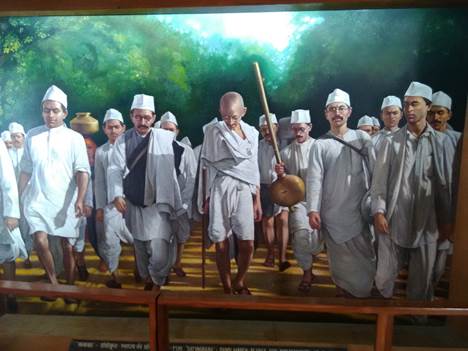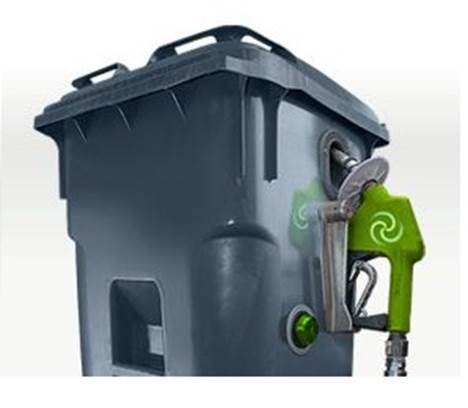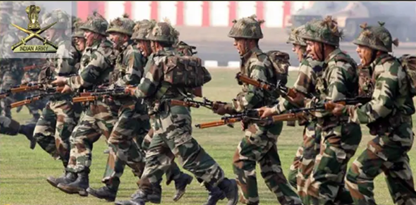AIR SPOTLIGHT
INDIAN SPACE SECTOR

Disclaimer: Copyright infringement not intended.
Context
- India is celebrating the 75th anniversary of its Independence. Under which the government is trying to enhance focus on various sectors of the economy including the space sector.
- India’s space journey after the inception of the Indian Space Research Organisation (ISRO) has been tremendous and has also transformed the country.
- India’s relationship with astronomy dated further back in history to the year 499 when Aryabhata began writing on space. He noted that the Earth was round and rotated on its axis. In 598, Brahmagupta was trying to calculate the circumference of the planet.
About ISRO
- India decided to go to space when Indian National Committee for Space Research (INCOSPAR) was set up by the Government of India in 1962. With the visionary Dr Vikram Sarabhai at its helm, INCOSPAR set up the Thumba Equatorial Rocket Launching Station (TERLS) in Thiruvananthapuram for upper atmospheric research.
- Indian Space Research Organisation, formed in 1969, superseded the erstwhile INCOSPAR. ISRO then embarked on its mission to provide the Nation with space-based services and to develop the technologies to achieve the same independently.
- Throughout the years, ISRO has upheld its mission of bringing space to the service of the common man, to the service of the Nation.
- In the process, it has become one of the six largest space agencies in the world.
- ISRO maintains one of the largest fleets of communication satellites (INSAT) and remote sensing (IRS) satellites, that cater to the ever-growing demand for fast and reliable communication and earth observation respectively.
- ISRO develops and delivers application-specific satellite products and tools to the Nation: broadcasts, communications, weather forecasts, disaster management tools, Geographic Information Systems, cartography, navigation, telemedicine, and dedicated distance education satellites being some of them.
- To develop cost-efficient and reliable launch systems, ISRO launches the Polar Satellite Launch Vehicle (PSLV) and Geosynchronous Satellite Launch Vehicle (GSLV).
Progress of Space sector from 1947 to 2022
- Indian Space programme is not as old as the independence. It started much later, the ISRO and the Department of Space by taking the lead became the jewel in the crown of India.
- India’s space journey started small and is now having up and reaching a stage where it will soon start competing with the big powers of the world and get into commercial space.
- So, a journey which started with a small satellite launched from the former USSR to now where India has end-to-end capabilities for; making satellites, making rockets and then doing interplanetary leads. This concludes that India’s journey since its independence is remarkable.
India has witnessed how its various space programmes have helped not just border security but also the weather prediction capability which also improved from the earlier days.
What are the sectors which have benefited in this period of the space journey in India?
- When India became independent, it was dependent on ground-based observations for weather predictions. The first hybrid satellite, where both communication and weather instruments were put together anywhere in the world, came from India and the ISRO.
- Since then, India has dedicated satellites which take Earth images on an hourly basis and also help in weather forecasting. Similarly, satellites are monitoring the ocean and the Himalayas.
- The remarkable difference which has been made between weather prediction and weather forecasting is forecasting the path of cyclones. With India being a peninsula country, cyclone formations are recurrent phenomena. Today, the satellites can forecast accurately which gives time for evacuation if needed.
- Other areas like:
- ATMs which connect with the satellite and the data is conveyed up and down for a transaction,
- from Doordarshan – one national channel to now having hundreds of television channels of different genres,
- benefit to agriculture in forecasting monsoon and governance like Smart City
In the Cold War era, space exploration was limited to two big powers; the former USSR and USA. But now, countries like India taking a lead in space whether it’s launching their satellites or also providing services to other countries. Similarly, India is competing with big countries by sending a satellite to Mars.
How to measure the success of a country like India in this area?
- If one goes by India’s space missions in the past, it is not just Earth observation but India also did interplanetary observations and the first big success came through Chandrayan-1.
- The Chandrayan-1 was a huge success for India because it happened at a time when there was technology denial due to international sanctions on India. The remarkable outcome of Chandrayan-1 was that India brought the first evidence of the presence of water molecules on the surface of the moon and re-wrote the lunar planetary history.
- Later came India’s Mangalyaan mission, this was India’s maiden attempt outside Earth’s gravity to another planet. In its maiden attempt, it reached the Mar’s orbit which was not even achieved by big powers like the USA, Russia and China.
- India’s Chandrayan-2 received setbacks when the lander and rover did not achieve their desired target and also recently SSLV-D1 placed the satellite in an elliptical orbit rather than a circular one, leaving them “unusable”, are a few of the failures where India seeks to learn for the success of Gaganyaan mission – where India will be sending its female astronaut on an Indian rocket from Indian soil into the space.
Concerning Gaganyaan, what can be expected on this front?
- India has already trained four of its Indian Air Force (IAF) pilots as astronauts and they are continuing to train. India is also developing its Geosynchronous Satellite launch vehicle – Mark 3 launcher to make it human rated and then the allied technologies of life support have also been developed.
- Incidentally, the food that is necessary for the astronauts are all being prepared in India, the work is in progress and the government has allocated about Rs. 9000 crores for this mega project.
- There would be two uncrewed or unmanned spaceflights which will be attempted in the coming months after which it will be manned spaceflights. Before India, the former USSR, the USA and China have been able to achieve such kinds of missions.
The Indian space program is not just benefiting the Indian citizens or India as such. Many countries especially developing and under-developed countries around the world are dependent on Indian space data.
How India is benefiting the world community with its space journey?
- Though India has helped developing countries in launching their satellites on its rocket but India’s space sector is still in its nascent stage as compared to global players like Russia and the USA.
- As far as data is concerned, India’s Earth observation satellites have remarkable capabilities whose pictures are in high demand both in India and abroad. This has helped not just India in its rapid development for a new India in its Amrit Kal but also helping the developing world.
- Jointly, India and USA are developing a satellite called NISAR with NASA and ISRO and this will be an Earth observation satellite. This will be the one satellite which the world will look forward for its data as far as monitoring glaciers, waterways and vegetation is concerned across the globe.
In the coming time, it is expected to see a refinement in both communication satellites and satellite-based internet which will become omnipresent across India. The refinement in imaging is going to be an important aspect of Earth observation as India goes ahead. India’s space start-up will be a major prospect for India as there are now more than 50 start-up companies which are working in space technologies since Prime Minister Narendra Modi has unlocked the space sector and with the launch of 5G, this nascent sector will rev up and offer many solutions.
https://newsonair.gov.in/Spotlight.aspx#
https://t.me/+hJqMV1O0se03Njk9

NEWS IN BRIEF: PRELIMS SPECIAL
Quit India Movement

Disclaimer: Copyright infringement not intended.
Context
- On the anniversary of the Quit India Movement, Vice President M Venkaiah Naidu and Prime Minister Narendra Modi remembered the contribution of freedom fighters made during the Movement.
About Quit India Movement
- The Quit India movement was one such episode of the country's freedom struggle that was launched at the Bombay session of the All-India Congress Committee by Mahatma Gandhi on August 8, 1942, demanding the British end its rule in India.
- Based on this resolution, the Bharat Chhodo Andolan marked the beginning of a large-scale non-violent mass struggle for the country’s independence.
- Every social group, from peasants to students and workers who disrupted day-to-day lives, went on strikes to express their resentment against colonial rule. Peasants in Bengal fought against the increase in taxes. Government officials also broke laws to contribute to the independence movement.
- Women too participated in large numbers. One such revolutionary was Matangini Hazra, who led a huge number of villagers to destroy a police station in Bengal, following which she was shot dead. Several other prominent women freedom fighters like Pritilata Wadedar and Kanaklata Baruah laid down their lives for the country.
- Adoption of Indian attire like the ‘dhoti kurta’ and ‘Gandhi cap’ was also a widely celebrated feature of this movement.
- At the Gowalia Tank Maidan, Mahatma Gandhi in a historic speech said, "The power, when it comes, will belong to the people of India, and it will be for them to decide to whom it is placed....". The movement paved the way for the future of the Indian political landscape and will forever remain a golden chapter of the freedom struggle of India.
- However, the movement didn’t work out as it was expected to due to the sudden arrest of most of the Congress leaders in the early hours of 9 August. They were lodged in prisons in different parts of the country and the congress party was banned.
- Lack of leadership, suppression by the British authorities, poor coordination, and the lack of a clear plan of action marred the August Movement. Though it was successful in its goal of uniting the Indian masses.
https://newsonair.gov.in/News?title=Vice-President-M-Venkaiah-Naidu%2c-PM-Modi-remember-contribution-of-freedom-fighters-on-anniversary-of-Quit-India-Movement&id=445726
https://t.me/+hJqMV1O0se03Njk9
Government e-Marketplace (GeM)

Disclaimer: Copyright infringement not intended.
Context
- The Cooperation Minister Amit Shah e-launched the onboarding of cooperatives on the Government e-Marketplace (GeM) portal. 589 cooperatives have been shortlisted as eligible for onboarding.
About GeM
- Government e-Marketplace owes its genesis to the recommendations of two Groups of Secretaries made to the Prime Minister in January 2016. They recommended setting up a dedicated e-market for different goods & services procured or sold by Government/PSUs besides reforming the Directorate General of Supplies and Goods (DGS&D).
- Subsequently, the Finance Minister in his Budget speech for FY 2016-17, announced the setting up of a technology-driven platform to facilitate the procurement of goods and services by various Ministries and agencies of the Government.
- DGS&D with technical support of the National e-Governance Division (Ministry of Electronics and Information Technology) has developed a GeM portal for procurement of both Products & Services.
- The portal was launched on 9th August 2016 by the Commerce & Industry Minister. Procurement on GeM has been authorized by General Financial Rules by making necessary changes in government rules.
- Presently more than 7400 products in about 150 product categories and hiring of transport services are available on the GeM POC portal. Transactions for more than Rs 140 Crore have already been processed through GeM.
- GeM is a completely paperless, cashless and system-driven e-marketplace that enables procurement of common-use goods and services with minimal human interface.
- GeM aims to enhance transparency, efficiency and speed in public procurement. It provides the tools of e-bidding, reverses e-auction and demand aggregation to facilitate the government users, and achieve the best value for their money.
https://newsonair.gov.in/News?title=Union-Minister-Amit-Shah-e-launches-onboarding-of-cooperatives-on-GeM-portal&id=445706
https://t.me/+hJqMV1O0se03Njk9
2nd Generation (2G) Ethanol Plant

Disclaimer: Copyright infringement not intended.
Context
- Prime Minister Narendra Modi to dedicate to the nation the 2nd Generation (2G) Ethanol Plant at Panipat in Haryana through video conferencing. It is in line with the Prime Minister’s constant endeavour to transform the energy sector into being more affordable, accessible, efficient and sustainable.
- The 2G Ethanol Plant has been built at an estimated cost of over nine hundred crore rupees by the Indian Oil Corporation Limited.
About Ethanol
- Ethanol is a grain alcohol that can be blended with gasoline and used in motor vehicles. Many gasoline stations provide a blended fuel, which typically is 10 per cent ethanol and 90 per cent gasoline.
- Ethanol can be fermented from many sources of starch, including corn, wheat, grain sorghum, barley, and potatoes, and sugar crops such as sugar cane and sweet sorghum.
- Generation of biofuels:
- First-generation biofuels are made from sugar, starch, and vegetable oil. Biologically produced fuels such as ethanol, propanol, and butanol are produced by the action of microorganisms and enzymes through the fermentation of sugars or starches or cellulose.
- Second-generation biofuels are also called “olive green” or “cellulosic-ethanol” fuel and are mainly obtained from supportable or non-food feedstocks. Waste vegetable oil, forest residue, industry residue, and sustainable biomass are the primary feedstock for the production of second-generation biofuels.
- Third-generation biofuels are also known as “algae fuel” or “oilage” since they are produced from the algae. Algae lead to the production of all types of bio-fuels such as biodiesel, gasoline, butanol, propanol and ethanol with a high yield, approximately 10 times higher than the second-generation biofuel. Cultivation of third-generation biofuel biomass also assists in maintaining environmental balance by consuming the CO2 present in the atmosphere.
- Fourth-generation biofuels are the result of developments in plant biology and biotechnology (metabolic engineering) in the field of carbon capture and storage technique. This requires an advanced method for biofuel production. In this generation, bio-engineered plants/trees/algae function as a carbon capture machine to lock carbon in their different parts, that is, leaves, branches, etc., for the feedstock generation of biofuel.
https://newsonair.gov.in/News?title=PM-to-dedicate-to-nation-2G-ethanol-plant-at-Panipat-in-Haryana-on-August-10&id=445713
https://t.me/+hJqMV1O0se03Njk9
Ex Vajra Prahar 2022

Disclaimer: Copyright infringement not intended.
Context
- The 13th Edition of the Indo-US Joint Special Forces exercise “Ex Vajra Prahar 2022” commenced at the Special Forces Training School at Bakloh of Himachal Pradesh.
About Ex Vajra Prahar 2022
- The joint exercise by the Special Forces of both the countries is conducted alternatively between India and the United States to share the best practices and experiences in areas such as joint mission planning and operational tactics.
- The US contingent is represented by personnel from the 1st Special Forces Group (SFG) and Special Tactics Squadron (STS) of US Special Forces and the Indian Army contingent is formed by drawing Special Forces personnel under the aegis of SFTS.
- During 21 days, teams of both armies would jointly train, plan and execute a series of Special Operations, Counter Terrorist Operations, and Air Borne operations in simulated conventional and unconventional scenarios in mountainous terrain.
- This joint exercise is a significant step in strengthening the traditional bond of friendship between the special forces of both Nations as well as improving bilateral defence cooperation between India and the USA.
- Bilateral military exercises and defence exchanges are an important facet of deepening bilateral defence cooperation between friendly countries.
https://newsonair.gov.in/News?title=India%2cUS-begin-joint-Special-Forces-exercise-at-Bakloh-in-Himachal-Pradesh&id=445709
https://t.me/+hJqMV1O0se03Njk9
Pradhan Mantri Kaushal Vikas Yojana (PMKVY)

Disclaimer: Copyright infringement not intended.
Context
- The Minister of State for Skill Development Rajeev Chandrasekhar in a written reply in the Lok Sabha stated that 1.37 crores of candidates have benefited from the Pradhan Mantri Kaushal Vikas Yojana (PMKVY) since its inception till June 2022.
About PMKVY
- Pradhan Mantri Kaushal Vikas Yojana (PMKVY) is the flagship scheme of the Ministry of Skill Development and Entrepreneurship (MSDE) implemented by the National Skill Development Corporation (NSDC).
- The objective of this Skill Certification Scheme is to enable Indian youth to take up industry-relevant skill training that will help them in securing a better livelihood.
- Individuals with prior experience are also assessed and certified under Recognition of Prior Learning (RPL).
- Toto empowers the country’s youth and continues the journey of the Skill India Mission in building India as the skill capital of the world, the Ministry of Skill Development and Entrepreneurship (MSDE) launched the third phase of its flagship scheme — Pradhan Mantri Kaushal Vikas Yojana (PMKVY 3.0) on 15 January 2021.
- PMKVY 3.0 will encourage and promote skill development throughout the country to address industry needs, meet market demands and impart skills in services and in new-age job roles that have become crucial with the advent of the COVID-19 pandemic. Incorporating the learnings from PMKVY 1.0 and PMKVY 2.0, PMKVY 3.0 will be implemented in a more decentralised structure with greater responsibilities and support from States/UTs and Districts.
- District Skill Committees (DSCs), under the guidance of State Skill Development Missions (SSDM), shall play a key role in addressing the skill gap and assessing demand at the district level. The new scheme will be more trainee and learner-centric addressing the ambitions of Atmanirbhar Bharat.
- The scheme has two components — the Central Component to be implemented by the National Skill Development Corporation (NSDC), Directorate General of Training (DGT) and other agencies of the Central Ministries and the State Component to be implemented by the State Skill Development Missions (SSDMs)/respective Departments of the States/UTs. Skill training will be imparted under three categories, pan-India:
- Short Term Training (STT)
- Recognition of Prior Learning (RPL)
- Special Project (SP)
- The focus of PMKVY 3.0 (2020-21) has been shifted from a supply-based approach to a demand-based approach.
- In the wake of disruption caused by COVID-19 and the resultant impact on livelihood, the scheme (PMKVY 3.0) will give a major focus on upskilling/reskilling with a focus on future skills (industry 4.0) courses to increase the productivity of the existing workforce and provide online/digital mode of training for wider coverage.
https://newsonair.gov.in/News?title=1.37-crore-candidates-benefited-from-Pradhan-Mantri-Kaushal-Vikas-Yojana&id=445702
https://t.me/+hJqMV1O0se03Njk9









